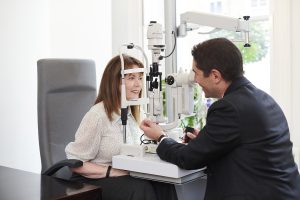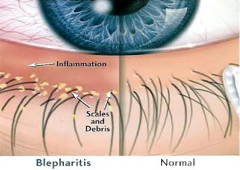Eye Conditions: What is Anterior Blepharitis?

Our eyes are complex organisms with over two million working parts – each of which must work together to ensure the health and function of the eye. As such, the eyes are considered the second most complex organ in the body, second only to the brain. But with so many components, it can be easy for something to go wrong.
In this article, we’ll be taking a look at the causes and types of blepharitis and meibomian gland dysfunction (MGD). According to a 2023 study, more than 50% of patients seeking ophthalmologic consultations have symptoms and signs indicating one or both of these diseases. So, what are they and what causes them?
What is Blepharitis?
Put simply, blepharitis refers to inflammation of the eyelids. It is usually associated with bacterial infection of the eyelids or eyelashes; however, it may also be linked to other underlying conditions such as seborrheic dermatitis. This can cause an overproduction of sebum (oil) from the sebaceous glands around the eyelashes.
Blepharitis can cause inflammation, itchiness and swelling around the eyelids. Other symptoms may occur depending on the cause and type of blepharitis. There are two types of blepharitis: Anterior blepharitis and posterior blepharitis.
Anterior blepharitis occurs when the disease affects the anterior (outside) part of the eyelids. It is most commonly caused due to infection by the bacteria Staphylococcus at the base of the eyelashes (Staphylococcal anterior blepharitis). It is characterised by flaking or crusting on the lashes and redness of the lid margins.
Posterior blepharitis affects the inner part of the eyelid margin – the part that touches the eye. It occurs when the meibomian glands (the oil-producing glands around the eyes) become clogged. As these glands are responsible for the secretion of the oil layer of the tear film, dysfunction can affect the stability of the eye’s surface. Hence, posterior blepharitis is often also referred to as meibomian gland dysfunction (MGD).
Both anterior and posterior blepharitis can cause symptoms of dryness, grittiness and general irritation in the eyes. Some people will not notice any symptoms apart from sporadic periods of dry eyes.
Meibomian Gland Dysfunction (MGD)
As mentioned above, the healthy function of the meibomian glands is essential for maintaining the stability of the tear film. These glands secrete the lipid (oily) layer of the tear film, which is vital in preventing the evaporation of tears on the surface of the eye. This keeps the eyes hydrated and aids in clear vision.
In MGD the meibomian glands become unable to produce or secrete the necessary oils. As a result, patients may experience dry eyes and other symptoms. Despite being a relatively common problem, MGD often goes undiagnosed and, even when diagnosed, it is often not treated effectively.
Treatments For Anterior Blepharitis and MGD
Promoting the health of the meibomian glands and the general cleanliness of the eyelids is the most effective way to manage blepharitis and MGD. It is important to comply with a consistent and long-term treatment regime to prevent the reoccurrence of the conditions.
The recommended treatment of blepharitis may depend on the severity of the condition; however, the most common and most effective treatment is regular eyelid scrubs or compresses. This involves:
- Soaking a cotton pad or clean flannel in warm water and place on your closed eyes for 5 to 10 minutes.
- Gently massage the eyelids for around 30 seconds (this will help to remove any remaining blockages in the meibomian glands in MGD).
- Clean your eyelids using a fresh cotton pad or bud to remove any flakes around the eyes. It may also help to use a small amount of baby shampoo.
In some cases, your optometrist may recommend other proprietary cleansers, which can be ordered online. These may include:
- Ocusoft Pads
- Lid-Care Sterile Wipes
- Supranettes
Consistency is Key
The eyelid cleaning routine should be carried out morning and night, or as prescribed by your practitioner. When symptoms begin to improve, you should continue to clean your eyelids once a day. However, it is important to continue with this cleansing routine, even if your symptoms completely clear up. This can help to prevent reoccurrence of the condition.
In more chronic cases, you may also be prescribed an antibacterial product such as Fucithalmic eye drops which is to be taken as advised by your optometrist or ophthalmologist.
You will also be advised that you do not wear contact lenses while experiencing symptoms of blepharitis or MGD. Lenses can exacerbate dry eye symptoms and put you at a higher risk of eye infections. You should also avoid eye makeup during these periods – particularly eyeliner and mascara.
Blepharitis and Laser Eye Surgery
Blepharitis is a common but often manageable condition. However, it is necessary to ensure the effective treatment of anterior and posterior blepharitis before having Laser Eye Surgery. This is because refractive laser surgery can often cause short-term dry eye symptoms and worsen existing dry eye symptoms.
At your comprehensive screening appointment, your doctor will be able to determine your suitability for Laser Eye Surgery and discuss your options with you. This may involve a delay in your treatment to ensure the best outcomes and the least risk of side effects.
If you would like to learn more about your suitability for Laser Eye Surgery, get in touch with one of our friendly clinic coordinators today. Alternatively, Book a Consultation using the form below to start your journey to clear, glasses-free vision.



